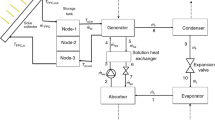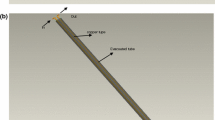Abstract
This paper presents the comprehensive thermodynamic modelling to compare the performance and optimization of single-stage NH3–H2O-type absorption cooling system integrated with different solar collector types for the city of Mehsana, India. A 20-kW system at 0 °C is analysed which includes four different solar collectors flat-plate collectors, parabolic-trough collectors (PTC), flat plate with compound parabolic collector reflectors and evacuated-tube collectors (ETC) attached with insulated thermal storage tank to power the NH3–H2O vapour absorption system. The study investigated the effect of heat source temperature on performance aspects of systems. The examined performance parameters are exergetic efficiency, coefficient of performance and area of collector. Exergetic optimization of each system estimated the optimum collecting area requirement for cooling. Differentiation between optimized systems determined that the optimum cost, SCOP and ηII,system of PTC-type system are averagely 30, 11 and 0.5% higher than ETC-type system at different ambient temperatures. For effective comparison and conclusion, key performance indicator is evaluated to select optimum system configuration from both thermodynamic and economic criteria.













Similar content being viewed by others
Abbreviations
- A :
-
Area (m2)
- C collectorr :
-
Specific cost of collector (€ m−2)
- C p :
-
Specific heat (kJ kg−1 K−1)
- C R :
-
Area concentration ratio
- E X :
-
Exergy (kW)
- G b :
-
Beam irradiance (W m−2)
- G d :
-
Diffused irradiance (W m−2)
- G T :
-
Irradiance (W m−2)
- m · :
-
Mass flow rate (kg s−1)
- M :
-
Water mass in storage tank (kg)
- P :
-
Pressure (kPa)
- Q · :
-
Heat load (kW)
- R b :
-
Beam radiation factor
- SCOP:
-
Solar COP
- T :
-
Temperature (K)
- U L :
-
Overall heat loss coefficient (W m−2 K−1)
- W · :
-
Work (kW)
- η :
-
Efficiency
- ρ w :
-
Water density (kg m−3)
- η I :
-
First law efficiency
- η II :
-
Second law efficiency
- β :
-
Inclination of collector (°)
- ρ :
-
Ground reflectance
- ϕ :
-
Latitude (°)
- A :
-
Absorber
- C :
-
Condenser
- E :
-
Evaporator
- G :
-
Generator
- in:
-
Inlet stream
- min:
-
Minimum
- out:
-
Outlet stream
- P :
-
Pump
- r :
-
Refrigerant
- st:
-
Storage tank
- st1:
-
Tank first zone
- st2:
-
Tank second zone
- st3:
-
Tank third zone
- sun:
-
Sun
- ss:
-
Strong solution
- ws:
-
Weak solution
- o :
-
Ambient
- CFC:
-
Chlorofluorocarbons
- COP:
-
Coefficient of performance
- CPC:
-
Flat plate with compound parabolic collector reflectors
- ETC:
-
Evacuated tube collector
- FPC:
-
Flat-plate collector
- HCHC:
-
Hydrochlorofluorocarbons
- PTC:
-
Parabolic-trough collector
- VARS:
-
Vapour absorption refrigeration system
- VCRS:
-
Vapour compression refrigeration system
References
Wu S, Eames IW. Innovations in vapour-absorption cycles. Appl Energy. 2000;66:251–66.
Fan Y, Luo L, Souyri B. Review of solar sorption refrigeration technologies: development and applications. Renew Sustain Energy Rev. 2007;11:1758–75.
Calm JM. Emissions and environmental impacts from air-conditioning and refrigeration systems. Int J Refrig. 2002;25:293–330.
Rosen M, Dincer I. Exergy as the confluence of energy, environment and sustainable development. Exergy. 2001;1:1–11.
Kotas TJ. The exergy method of thermal plant analysis. London: Butterworth; 1985.
Kumar V, Pandya B, Matawala V. Thermodynamic studies and parametric effects on exergetic performance of a steam power plant. Int J Ambient Energy. 2017. https://doi.org/10.1080/01430750.2017.1354326
Panchal S, Dincer I, Agelin-Chaab M. Thermodynamic analysis of hydraulic braking energy recovery systems for a vehicle. J Energy Resour Technol. 2016;138:011601.
Prabakaran R, Mohan Lal D. A novel exergy based charge optimisation for a mobile air conditioning system. J Therm Anal Calorim. 2018. https://doi.org/10.1007/s10973-018-6998-0
Raveendran PS, Sekhar SJ. Exergy analysis of a domestic refrigerator with brazed plate heat exchanger as condenser. J Therm Anal Calorim. 2017;2017(127):2439–46.
Anand S, Gupta A, Tyagi SK. Comparative thermodynamic analysis of a hybrid refrigeration system for promotion of cleaner technologies. J Therm Anal Calorim. 2014;117:1453–68.
Myat A, Thu K, Kim YD, Chakraborty A, Chun WG. A second law analysis and entropy generation minimization of an absorption chiller. Appl Therm Eng. 2011;31:2405–13.
Adewusi SA, Zubair SM. Second law based thermodynamic analysis of ammonia water absorption systems. Energy Convers Manag. 2004;45:355–69.
Kumar V, Pandya B, Patel J, Matawala V. Cut-off temperature evaluation and performance comparison from energetic and exergetic perspective for NH3–H2O absorption refrigeration system. Therm Sci Eng Prog. 2017;4:97–105.
Panchal S, Dincer I, Agelin-Chaab M. Analysis and evaluation of a new renewable energy based integrated system for residential applications. Energy Build. 2016;128:900–10.
Paria S, Baradaran S, Amiri A, Sarhan AAD, Kazi SN. Performance evaluation of latent heat energy storage in horizontal shell-and-finned tube for solar application. J Therm Anal Calorim. 2016;123:1371–81.
Aman J, Ting SK, Henshaw P. Residential solar air conditioning: energy and exergy analyses of an ammonia-water absorption cooling system. Appl Therm Eng. 2014;62:424–32.
Barhoumi M, Ezzine B, Bellagi A. Exergy analysis of an ammonia-water absorption system. Int J Exergy. 2009;6:698–714.
Dixit M. Thermodynamic analysis of GAX and hybrid GAX aqua-ammonia vapours absorption refrigeration systems. Int J Hydrog Energy. 2015;40:256–65.
Khaliq A, Kumar R. Exergetic analysis of solar powered absorption refrigeration system using LiBr–H2O and NH3–H2O as working fluids. Int J Exergy. 2007;4:1–18.
May SE, Boukholda I, Belagi A. Energetic and exergetic analysis of a commercial ammonia-water absorption chiller. Int J Exergy. 2010;8:33–50.
Gebreslassie BH, Medrano M, Boer D. Exergy analysis of multi-effect water–LiBr absorption systems: from half to triple effect. Renew Energy. 2010;35:1773–82.
Onan C, Ozkan DB, Erdem S. Exergy analysis of a solar assisted absorption cooling system on an hourly basis in villa applications. Energy. 2010;35:5277–85.
Mahesh A, Kaushik SC. Solar adsorption refrigeration system using different mass of adsorbents. J Therm Anal Calorim. 2013;111:897–903.
Ghaddar NK, Shihab M, Bdeir F. Modeling and simulation of solar absorption system performance in Beirut. Renew Energy. 1997;10:539–58.
Bouaziz N, Lounissi D. Energy and exergy investigation of a novel double effect hybrid absorption refrigeration system for solar cooling. Int J Hydrog Energy. 2015;40:13849–56.
Ezzine NB, Barhoumi M, Mejbri K, Bellagi A. Irreversibilities in two configurations of the double generator absorption chiller. J Therm Anal Calorim. 2005;80:471–5.
Gupta A, Anand Y, Anand S, Tyagi SK. Thermodynamic optimization and chemical exergy quantification for absorption-based refrigeration system. J Therm Anal Calorim. 2015;122:893–905.
Pandya B, Kumar V, Patel J, Matawala VK. Optimum heat source temperature and performance comparison of LiCl–H2O and LiBr–H2O type solar cooling system. J Energy Resour Technol. 2018;140:051204.
Duffie JA, Beckman WA. Solar engineering of thermal processes. London: Wiley; 2006.
Kalogirou SA. Solar energy engineering: processes and systems. Cambridge: Academic; 2013.
Jafarkazemi F, Ahmadifard E. Energetic and exergetic evaluation of flat plate solar collectors. Renew Energy. 2013;56:55–63.
Petela R. Exergy analysis of solar radiation (Chapter 2). Solar thermal sciences and engineering applications. Boca Raton: CRC Press; 2013.
Patel J, Pandya B, Mudgal A. Exergy based analysis of LiCl–H2O absorption cooling system. Energy Proc. 2017;109:261–9.
Borge D, Colmenar A, Castro M, Martín S, Sancristobal E. Exergy efficiency analysis in buildings climatized with LiCl–H2O solar cooling systems that use swimming pools as heat sinks. Energy Build. 2011;43:3161–72.
Kalogirou SA. The potential of solar industrial process heat applications. Appl Energy. 2003;76:337–61.
Mani A. Handbook of solar radiation data for India. New Delhi: Allied Publishers; 1080. p. 1980.
Gogoi TK, Konwar D. Exergy analysis of a H2O–LiCl absorption refrigeration system with operating temperatures estimated through inverse analysis. Energy Convers Manag. 2016;110:436–47.
Author information
Authors and Affiliations
Corresponding author
Rights and permissions
About this article
Cite this article
Pandya, B., Kumar, V., Matawala, V. et al. Thermal comparison and multi-objective optimization of single-stage aqua-ammonia absorption cooling system powered by different solar collectors. J Therm Anal Calorim 133, 1635–1648 (2018). https://doi.org/10.1007/s10973-018-7193-z
Received:
Accepted:
Published:
Issue Date:
DOI: https://doi.org/10.1007/s10973-018-7193-z




